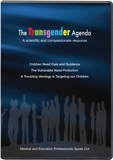Male and Female in His Image
God’s good design for men and women
From the moment of fertilization, a new human being is either male or female. While it will be some time before the biological sex of a developing child is visible, it is defined by the presence or absence of the Y chromosome—an individual with XX chromosomes is female, and an individual with XY chromosomes is male. (We will discuss people with intersex chromosomal disorders a little later.)
Going back to God’s Word, we see that biological sex is a core part of how we are created and is part of God’s good, original design.
There have always been people who haven’t been happy with their identity, but today there is an unprecedented number of young people who are claiming a sex identity other than their biological sex. Going back to God’s Word, we see that biological sex is a core part of how we are created and is part of God’s good, original design.
Biological Sex Is Not Necessarily a Particular Gender Role
It may be helpful to define what we are not speaking about. When people think of manhood, they may think of macho, muscled men obsessed with cars and power tools, or when they think of womanhood, they may think of the stereotypical 1950s housewife who does the housework in a dress and pearls and who has dinner ready on the table when her husband gets home. While there is nothing wrong with people who delight in certain stereotypically masculine or feminine activities, our biological sex does not necessitate that.
The Bible even portrays people who act in ways not necessarily culturally expected for their biological sex. For instance, Jacob preferred to stay in the tents (a more stereotypically “feminine” activity) versus his brother Esau who was the more masculine hunter. Jacob was masculine in other ways and went on to father 12 sons and at least 1 daughter, but he was not required to be stereotypically masculine in every way.
The Proverbs 31 woman, the idealized “perfect wife,” while performing many stereotypically feminine tasks, also takes a great deal of initiative in business and real estate. Lydia was an international businesswoman. Anna, after she was widowed as a young woman, served in the temple for the rest of her life instead of remarrying as the culture of that time would have expected of her. The Apostle Paul affirmed the goodness of people remaining single if that was the life God called them to.
In fact, some things the culture expects of men or women may be sinful. For instance, Roman men were expected to be unfaithful to their wives with both men and women. Some women were expected to expose their infants to perish in the elements if they were sickly, female, or otherwise unwanted. A myriad of other examples could be cited throughout history. Even today, many cultures have unbiblical expectations of men and women.
This means that when we think of manhood and womanhood, we need to carefully examine what the Bible says, including using the Bible’s teaching to challenge cultural assumptions where they are inconsistent with Scripture. Because God created men and women, he has the final say about what the roles of each are.
Men in God’s Image
God created Adam first and gave him the charge to rule the creation as a steward. When Adam sinned, God began the description of his failure with the words, “Because you have listened to the voice of your wife,” as opposed to obeying God’s explicit instruction (Genesis 3:17). God built the marital relationship to reflect the relationship between Christ and his church. Part of this is male headship, not as a tyrant, but as a leader with the attendant responsibilities. This leadership is intended to reflect how Christ leads and sacrifices for his church.
Biologically, men are, on average, taller than women and have more muscle mass, less fat, denser bones, a longer stride, and a wider “wingspan.” Even before considering the reproductive system or secondary sexual characteristics, the differences between male and female are so great that one’s biological sex is often visually apparent even from a distance. It is even possible to identify the biological sex of a deceased person from their skeletonized remains.
God created people to be in relationship with him and with other people, and so it makes sense that a man’s purpose is also revealed by his relationships with God and others. The first relationship God instituted was marriage—the union of a man and woman for companionship, mutual help, and childbearing.
While being a husband can be an important way some men express their created identity as men, the Bible also affirms that unmarried men also have important roles to play. The prophets Daniel and Jeremiah were not married, and neither was the Apostle Paul. Of course, Jesus, the perfect God-Man, never married.
Women in God’s Image
For most of history, a woman’s role has often been defined by her capacity to bear children. By the time a girl is born, she already possesses all the eggs she will ever have. A mature woman’s body has more fat than a man’s and has wider hips to allow for childbirth.
In marriage, God designed for the wife to be an indispensable help for her husband. In the creation account, we hear God declaring everything he created good, culminating with “very good” when creation is completed on day seven. So in Genesis 2, when God declares it is “not good” that Adam is alone, that should catch the reader’s attention. For the first time in the narrative, something is not good—and the solution is the creation of the woman.
Just as a man’s role is often typified by his relationships to others as husband and father, a woman’s role is often lived out in her relationships as wife and mother. The Proverbs 31 wife is an idealized look at a woman’s activities over time to help her household. She raises and teaches her children. She engages in profitable business to help provide for the household. She manages resources wisely so that the family is secure even in times of unrest or economic downturn. Further, her role typifies the relationship between the church and Christ. She is to respect and submit to her husband in the Lord as the church submits to Christ (Ephesians 5:22–24).
Just as unmarried men have an important role, so do unmarried and widowed women. Martha’s hospitality and Mary’s passion for learning from Jesus are praised in Scripture, and neither has a mentioned husband. Anna (Luke 2:36–38) did not remarry after she was widowed but served in the temple.
Manhood and Womanhood in a Fallen World
Sometimes, people feel uncomfortable with their biological sex because of the sinful actions of other people or the realities of a fallen world. Abuse can sometimes cause both men and women to question and even reject their biological sex.
Many want to show love to people who are confused about their identity by affirming their confusion, because confronting their rejection of their biological sex can increase their emotional distress in the moment. Some worry that non-affirmation may even increase suicide risk. However, it is always loving to kindly tell the truth, and we have an obligation to love fellow image-bearers by refusing to lie to them. Affirming a lie is never loving. In fact, it is the least loving thing that can be done.
Counseling that focuses on addressing the root of the confusion, whether it is abuse or social pressures, may be helpful to the individual. Getting young people away from social media and peer groups who encourage gender confusion may be critical. Many times, children begin their journey into sexual confusion through social media. In many public schools, teachers will help a child socially transition while concealing it from their parents. It is important for parents to be very engaged in their child’s life to recognize their child’s needs and help them navigate the wicked cultural trends of our age, and there are growing numbers of resources to help children and parents regarding this trend of gender confusion.
What About Intersex People?
When discussing “the gender spectrum,” people often mention intersex people as proof that humans aren’t a binary of either male or female. Sometimes a person is born with some ambiguity to their biological sex. This can be either because of a chromosomal disorder, such as Turner Syndrome or Klinefelter Syndrome, or because of androgen insensitivity, where an individual is born genetically male but develops visually as a female.
Intersex disorders happen in a fallen world. If Adam had never sinned, these and other medical conditions would not exist. These people did not choose to have these conditions, and they face genuine difficulties. It is disingenuous to “use” their medical condition to affirm voluntary choices in regard to gender.
A Gospel Opportunity
God delights to save all sorts of people, regardless of what they have done to their own bodies.
God delights to save all sorts of people, regardless of what they have done to their own bodies. There is a growing community of “de-transitioners” who have realized that their quest to become something they could never biologically attain could not bring them happiness. These people, above all, need the gospel. They need to know that even if there are parts of their “transition” that are not reversible, they can still turn to Christ and experience the joy of his salvation. Many of those who detransition are particularly open to the gospel as they are searching for something to replace the sexual humanism that they had followed into self-mutilation. Those who become believers need to be surrounded by church communities that can help them navigate the complexities of returning to their true biological selves as they serve their Creator together.
Recommended Resources

Answers in Genesis is an apologetics ministry, dedicated to helping Christians defend their faith and proclaim the good news of Jesus Christ.
- Customer Service 800.778.3390
- Available Monday–Friday | 9 AM–5 PM ET
- © 2025 Answers in Genesis







